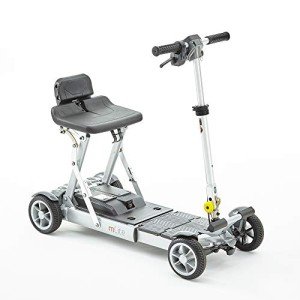Understanding Mobility Devices: Enhancing Independence and Quality of Life
In today's hectic world, the desire for mobility is universal. However, folding mobility scooters with remote key or age-related challenges can impede movement, causing a continuous look for assistance. Mobility devices serve as vital tools to boost independence, enhance quality of life, and allow people to engage fully in their neighborhoods. This article provides a comprehensive introduction of mobility devices, including their types, features, selection requirements, and more.
Kinds Of Mobility Devices
Mobility devices vary from easy aids to complicated devices, tailored to fulfill numerous requirements. Below is a table summing up common kinds of mobility devices:
| Type of Device | Description | Ideal For |
|---|---|---|
| Walkers | Four-legged assistance devices that supply exceptional stability while strolling. | People requiring additional support. |
| Walking canes | Single or three-legged sticks that enhance balance and support walking. | Those with slight mobility problems. |
| Wheelchairs | Seats installed on wheels, readily available in manual and electric versions. | People with limited or no mobility. |
| Scooters | Electric automobiles developed for outside usage and ease of navigation. | Those who can't walk fars away. |
| Crutches | Devices that help people move weight far from an injured leg. | People recuperating from leg injuries. |
| Rollators | Walkers with wheels, seats, and brakes for improved mobility. | Users needing rest options while strolling. |
| Lift Chairs | Reclining chairs that assist users in standing up and sitting down. | Seniors or those with mobility restrictions. |
| Mobility Scooters | Small electric vehicles for minimal mobility, frequently utilized outdoors. | Individuals requiring help over fars away. |
Key Features of Mobility Devices
When picking a mobility gadget, numerous key functions should be thought about to ensure optimum functionality and ease of use:
- Weight Capacity: Understanding the gadget's weight constraint is vital for security and efficiency.
- Adjustability: Devices needs to be adjustable in height and width to fit the user easily.
- Portability: Lightweight and foldable choices are necessary for users who travel or require transport.
- Stability and Safety: Look for features like anti-tip wheels and sturdy structures to boost safety.
- Ease of Use: Simple systems and easy to use designs can make a substantial distinction in day-to-day usage.
- Comfort: Ergonomic designs and cushioned seats can boost the user experience.
Choosing the Right Mobility Device
Selecting the right mobility device can be a daunting job. Here are some steps to guide the decision-making process:
- Assess Needs: Evaluate the person's mobility difficulties and daily activities.
- Seek advice from a Professional: Engage health care specialists who can offer recommendations based on the individual's physical condition.
- Trial Options: If possible, trial different devices to determine comfort and performance.
- Evaluation Budget: Consider the cost of the gadget, consisting of any extra functions or modifications required.
- Research study Options: Determine the very best brands and models by reading reviews and contrasts.
Table: Comparative Analysis of Popular Mobility Devices
| Gadget | Advantages | Downsides |
|---|---|---|
| Walkers | Excellent stability, promotes walking. | Bulky, might limit motion in small areas. |
| Canes | Lightweight, enhances balance. | Might not provide sufficient support for extreme mobility issues. |
| Wheelchairs | Ideal for those with significant mobility constraints. | Can be cumbersome, especially in indoor environments. |
| Scooters | Great for outdoor usage, easy to maneuver. | Limited indoor usability, heavier. |
| Rollators | Offers rest option, simple to move. | May require more area than traditional walkers. |
| Raise Chairs | Comfy, helps shift from sitting to standing. | More costly, bigger footprint. |
Regularly Asked Questions (FAQs)
1. What is a mobility device?
A mobility gadget is any tool developed to assist people in moving and navigating their environment. This includes walkers, wheelchairs, scooters, and crutches.
2. How do I understand which mobility device is best for me?
Consider your specific mobility challenges, physical capabilities, and way of life needs. Consulting with healthcare professionals can also offer customized recommendations.
3. Are mobility devices covered by insurance?
Many insurance coverage strategies, consisting of Medicare, may cover specific mobility devices. It's essential to check with your insurance provider for specific coverage information.
4. Can I rent a mobility device rather of purchasing one?
Yes, numerous medical supply stores and drug stores provide rentals for mobility devices. This alternative is helpful for individuals with short-term mobility issues.
5. How can I maintain my mobility gadget?
Regular upkeep is crucial. It consists of cleaning the device, looking for wear and tear, and guaranteeing all parts are working correctly.
The Impact of Mobility Devices on Quality of Life
Mobility devices significantly improve the lifestyle for people with restricted mobility. They foster independence, encourage social interaction, and boost access to vital services and leisure activities.
- Increased Independence: Users can navigate their areas, go to events, and participate in hobbies without counting on others.
- Social Engagement: Mobility devices help with participation in social events, consequently combating sensations of isolation.
- Boosted Safety: Devices supply stability and decrease the danger of falls, promoting user confidence.
Mobility devices are more than just tools for motion; they are entrances to self-reliance and quality living. By understanding the different types of mobility aids offered, their key features, and factors to consider for selecting the best device, individuals can make educated decisions about their mobility requires. Ultimately, the best mobility device can result in a more active, satisfying life. Whether it's a walker, wheelchair, or scooter, the ideal choice contributes substantially to enhancing the mobility and self-reliance of users.

